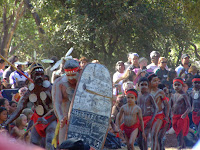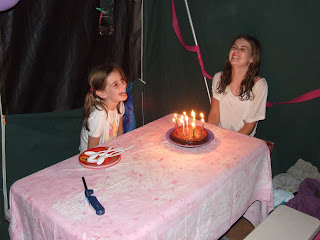 |
| Uncle Tommy George on left |
Laura, Cape York 16-19 June 2011
Our time at the Cape has now come to an end, nicely closed with 3 days in Quinkan Country at the Laura Dance Festival.
This meeting every 2 years of the various Murri and Islander communities from the tip of the Cape to down around Townsville is a major cultural event for these folk where they showcase their cultural lives with each other as well as for big mobs of tourists and travellers like us. Uncle Tommy George, one of the Traditional Owners of the area and the elder with custodial responsibility for the famed Quinkan art sites, welcomed us to his Country and presided over the 3 days of festivities. Around 500 dance performers compete for the Laura Shield before 5,000 or so visitors – it was a privilege to be amongst them all.
When you think that the wee hamlet of Laura consists of no more than about a dozen or so buildings, 100s of kilometres from a major town, you may well wonder how they cope with such a huge invasion of outsiders.
Fifteen kms out of town is the camp ground where the festival is held, nestled amongst the granite and sandstone cliffs that house the cultural sites. There’s no power, no phones, and water from the Laura River
Around the grassy and, at times, dusty dance ground, the steady pulse of the didgeridoo, percussion sticks and throaty chants drive on the stamping, whirling, jostling dancers. Many of the stories in the dances are similar across the communities – the crocs, the eagles, the willy wagtails, the snakes, the fish – but there is surprising diversity between the communities. The islander influence is certainly more noticeable in the northernmost Cape and Gulf troupes. Perhaps most amazing is the age range of the dancers – young kids aplenty, teens and young adults made up most of the participants, which seems to say that older folk are succeeding in passing on their stories and lore to their younger generations. Their collective skills in performance – young and old – are fantastic (and puts us whitefellas who can barely crack a waltz in time truly to shame).
The Lockhart River Cape and Gulf troupes. Perhaps most amazing is the age range of the dancers – young kids aplenty, teens and young adults made up most of the participants, which seems to say that older folk are succeeding in passing on their stories and lore to their younger generations. Their collective skills in performance – young and old – are fantastic (and puts us whitefellas who can barely crack a waltz in time truly to shame).
The girls enjoyed the music tent on Saturday night and given the way they mixed it with the mob when the Cold Water band from Wujal Wujal played, this was the first of many festivals to come!
We are off to Karumba next.








































